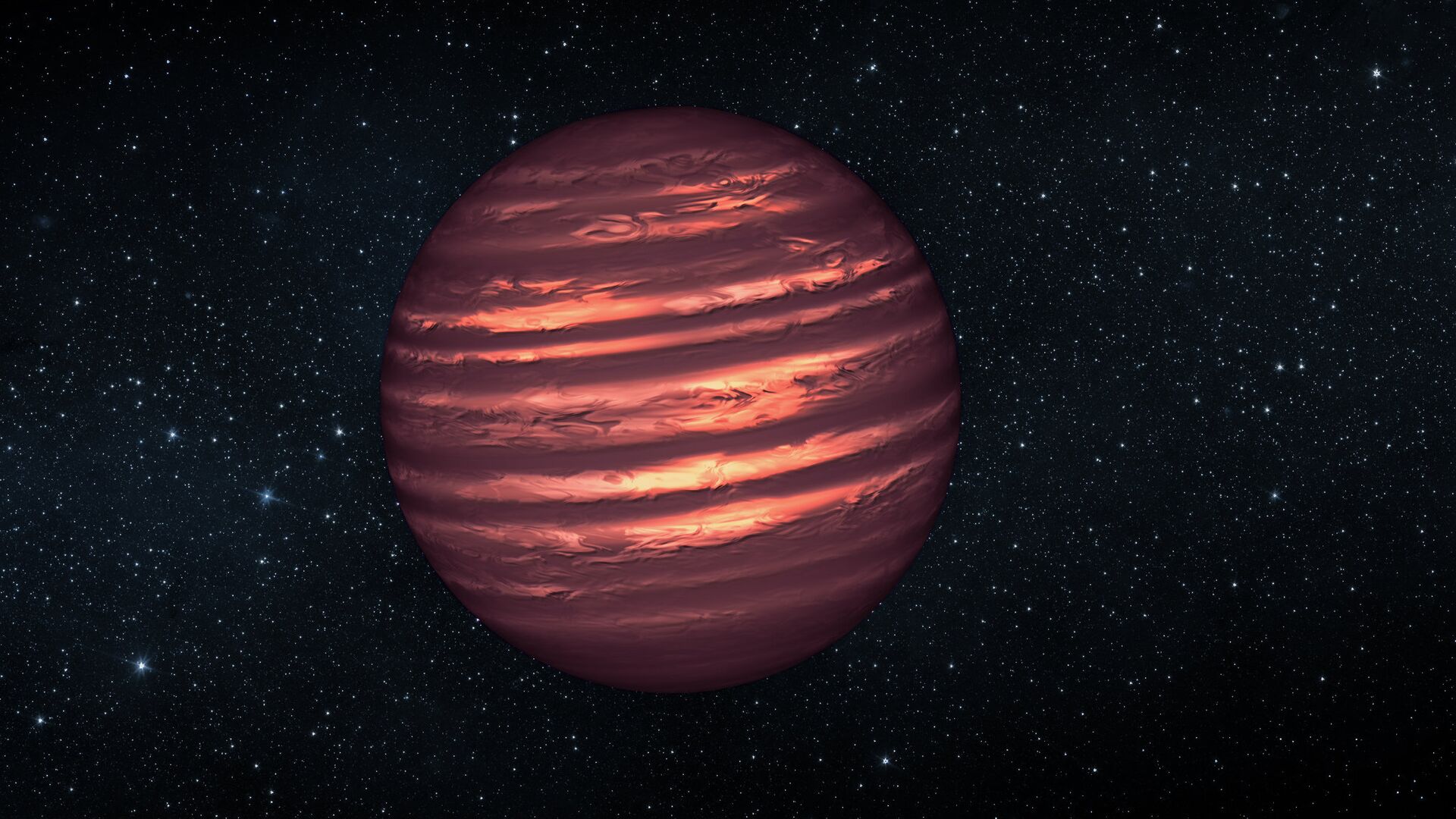https://sputnikglobe.com/20230714/astronomers-find-rare-failed-star-mysteriously-blasting-out-radio-emissions-1111880862.html
Astronomers Find Rare ‘Failed Star’ Mysteriously Blasting Out Radio Emissions
Astronomers Find Rare ‘Failed Star’ Mysteriously Blasting Out Radio Emissions
Sputnik International
Astronomers have stumbled upon a new stellar mystery after finding that a brown dwarf that is generating radio emissions capable of being detected from Earth, 37 light-years away.
2023-07-14T21:05+0000
2023-07-14T21:05+0000
2023-07-14T21:03+0000
beyond politics
brown dwarf
astronomy
jupiter
radio signals
australian square kilometer array pathfinder (askap)
https://cdn1.img.sputnikglobe.com/img/102528/89/1025288942_0:0:2048:1152_1920x0_80_0_0_fddcdea4f6d62c96f52065df1f358fa1.jpg
The T8 Dwarf WISE J062309.94−045624.6 is what they call a “failed star” or “hot Jupiter” because it lacks the mass required to trigger nuclear fusion of hydrogen into helium inside its core, which is the reaction that powers stars like our sun.In fact, WISE J062309.94−045624.6 is physically smaller than the planet Jupiter, although it’s estimated to be much denser, and thus having between 4 and 44 times the mass. Because they don’t give off much light, brown dwarfs were known only in the realm of theory until 1995.This brown dwarf is a rare discovery for two other reasons, though: First, it is an ultra-cool brown dwarf, with a surface temperature of about 800 degrees Fahrenheit (425 degrees Celsius) - cooler than a campfire’s flames and considerably cooler than both a main-sequence star or most other brown dwarfs. Second, the substellar object was spotted on a radio telescope, which detects the radio waves generated by much larger stars and space objects, such as black holes. Less than 10% of brown dwarfs generate such emissions."Finding this brown dwarf producing radio waves at such a low temperature is a neat discovery,” he added. “Deepening our knowledge of ultracool brown dwarfs like this one will help us understand the evolution of stars, including how they generate magnetic fields.”The discovery of its emissions was made using the CSIRO ASKAP telescope in Western Australia, and is discussed in an article published on Thursday in The Astrophysical Journal Letters. However, WISE J062309.94−045624.6 was first spotted in the skies in 2011.Exactly why or how this brown dwarf is making such powerful radio waves remains a mystery, but the astronomers have some theories.One theory holds that the rapid rotation of ultra-cool brown dwarfs helps spin up a strong magnetic field if it spins at a different rate than its ionized gaseous atmosphere. Neutron stars, which are the ultra-dense collapsed cores of once-massive stars, are believed to generate radio waves through a similar dynamic, shooting them and other types of electromagnetic radiation out of their polar regions. When humans first detected radio emissions from neutron stars in the mid-20th century, their regularity initially led to speculation that they were transmissions from an alien civilization.
https://sputnikglobe.com/20230611/diamond-in-the-sky-crystallizing-white-dwarf-star-spotted-in-solar-neighborhood-1111064149.html
Sputnik International
feedback@sputniknews.com
+74956456601
MIA „Rossiya Segodnya“
2023
News
en_EN
Sputnik International
feedback@sputniknews.com
+74956456601
MIA „Rossiya Segodnya“
Sputnik International
feedback@sputniknews.com
+74956456601
MIA „Rossiya Segodnya“
brown dwarf; hot jupiter; failed star; radio waves
brown dwarf; hot jupiter; failed star; radio waves
Astronomers Find Rare ‘Failed Star’ Mysteriously Blasting Out Radio Emissions
Astronomers have stumbled upon a new stellar mystery after finding a brown dwarf that is generating radio emissions capable of being detected from Earth, 37 light-years away.
The T8 Dwarf WISE J062309.94−045624.6 is what they call a “failed star” or “hot Jupiter” because it lacks the mass required to trigger nuclear fusion of hydrogen into helium inside its core, which is the reaction that powers stars like our sun.
In fact, WISE J062309.94−045624.6 is physically smaller than the planet Jupiter, although it’s estimated to be much denser, and thus having between 4 and 44 times the mass. Because they don’t give off much light, brown dwarfs were known only in the realm of theory until 1995.
This brown dwarf is a rare discovery for two other reasons, though:
First, it is an ultra-cool brown dwarf, with a surface temperature of about 800 degrees Fahrenheit (425 degrees Celsius) - cooler than a campfire’s flames and considerably cooler than both a main-sequence star or most other brown dwarfs.
Second, the substellar object was spotted on a radio telescope, which detects the radio waves generated by much larger stars and space objects, such as black holes. Less than 10% of brown dwarfs generate such emissions.
"It's very rare to find ultracool brown dwarf stars like this producing radio emission. That's because their dynamics do not usually produce the magnetic fields that generate radio emissions detectable from Earth," University of Sydney School of Physics Ph.D student Kovi Rose said in a statement.
"Finding this brown dwarf producing radio waves at such a low temperature is a neat discovery,” he added. “Deepening our knowledge of ultracool brown dwarfs like this one will help us understand the evolution of stars, including how they generate magnetic fields.”
The discovery of its emissions was made using the CSIRO ASKAP telescope in Western Australia, and is discussed in an article
published on Thursday in The Astrophysical Journal Letters. However, WISE J062309.94−045624.6 was first spotted in the skies in 2011.
"We've just started full operations with ASKAP, and we're already finding a lot of interesting and unusual astronomical objects like this," head of the University of Sydney School of Physics and research co-author Tara Murphy said. "As we open this window on the radio sky, we will improve our understanding of the stars around us and the potential habitability of exoplanet systems they host."
Exactly why or how this brown dwarf is making such powerful radio waves remains a mystery, but the astronomers have some theories.
One theory holds that the rapid rotation of ultra-cool brown dwarfs helps spin up a strong magnetic field if it spins at a different rate than its ionized gaseous atmosphere. Neutron stars, which are the ultra-dense collapsed cores of once-massive stars, are believed to generate radio waves through a similar dynamic, shooting them and other types of electromagnetic radiation out of their polar regions.
When humans first detected radio emissions from neutron stars in the mid-20th century, their regularity initially led to speculation that they were transmissions from an alien civilization.



